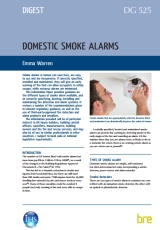Domestic smoke alarms DG525
BRE (Building Research Establishment) is an independent, research-based consultancy, testing and training organisation, operating in the built environment and associated industries. Domestic smoke alarms (DG525) was written by Emma Warren and published by BRE on 25 May 2012.
UK fire statistics show that you are almost twice as likely to die in a domestic fire where there is no working smoke alarm. Smoke alarms in homes are easy to use, inexpensive and can save lives giving early warning of fire, allowing occupants to safely escape. They are simple, self-contained but often interconnected units, incorporating a smoke detector, power source and alarm sounder. There are two types of domestic smoke alarm in common use: one is fitted with an ionisation smoke detector, the other with an optical or photoelectric detector.
DG525 provides guidance on the types of domestic smoke alarm available, and on their correct specification, location, installation and maintenance. It reviews recommendations in the relevant regulatory guidance and the use of third-party-approved fire detection and alarm products and installers.
It is intended for UK house builders, building control officers, specifiers, manufacturers, building owners and the fire and rescue services. It may also be of use to professionals in other countries.
The contents of the 8 page information paper are:
- Introduction.
- Types of smoke alarm.
- Interconnection.
- Power sources.
- Selecting smoke alarms.
- Specifying fire detection and alarm systems.
- Installation and siting.
- Maintenance.
- Summary.
- References.
[edit] Find out more.
[edit] Related articles on Designing Buildings Wiki
- BRE articles on Designing Buildings Wiki.
- BRE Buzz.
- BRE Buzz articles on Designing Buildings Wiki.
- BS 5839-1.
- Building Research Establishment.
- Carbon monoxide detector.
- Fire detection and alarm system.
- Fire detector.
- Fire.
- Ionisation smoke alarm.
- Multi-sensor alarm.
- Optical smoke alarm.
- Smoke detection in high ceiling spaces.
- Smoke detector.
- The causes of false fire alarms in buildings.
Featured articles and news
One of the most impressive Victorian architects. Book review.
RTPI leader to become new CIOB Chief Executive Officer
Dr Victoria Hills MRTPI, FICE to take over after Caroline Gumble’s departure.
Social and affordable housing, a long term plan for delivery
The “Delivering a Decade of Renewal for Social and Affordable Housing” strategy sets out future path.
A change to adoptive architecture
Effects of global weather warming on architectural detailing, material choice and human interaction.
The proposed publicly owned and backed subsidiary of Homes England, to facilitate new homes.
How big is the problem and what can we do to mitigate the effects?
Overheating guidance and tools for building designers
A number of cool guides to help with the heat.
The UK's Modern Industrial Strategy: A 10 year plan
Previous consultation criticism, current key elements and general support with some persisting reservations.
Building Safety Regulator reforms
New roles, new staff and a new fast track service pave the way for a single construction regulator.
Architectural Technologist CPDs and Communications
CIAT CPD… and how you can do it!
Cooling centres and cool spaces
Managing extreme heat in cities by directing the public to places for heat stress relief and water sources.
Winter gardens: A brief history and warm variations
Extending the season with glass in different forms and terms.
Restoring Great Yarmouth's Winter Gardens
Transforming one of the least sustainable constructions imaginable.
Construction Skills Mission Board launch sector drive
Newly formed government and industry collaboration set strategy for recruiting an additional 100,000 construction workers a year.
New Architects Code comes into effect in September 2025
ARB Architects Code of Conduct and Practice available with ongoing consultation regarding guidance.
Welsh Skills Body (Medr) launches ambitious plan
The new skills body brings together funding and regulation of tertiary education and research for the devolved nation.
Paul Gandy FCIOB announced as next CIOB President
Former Tilbury Douglas CEO takes helm.
























